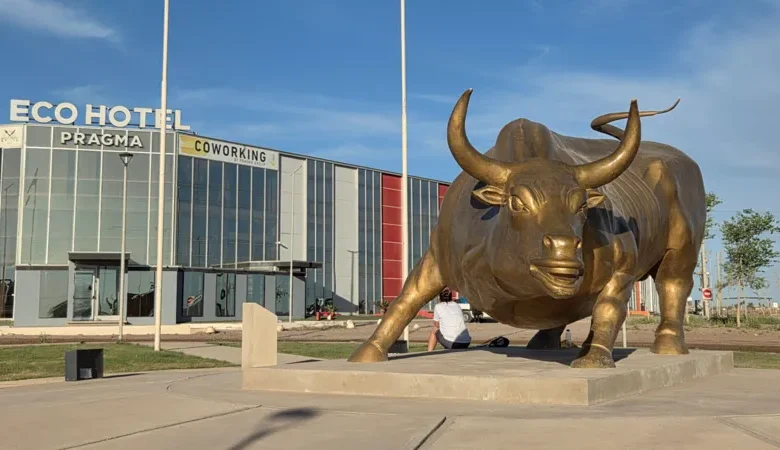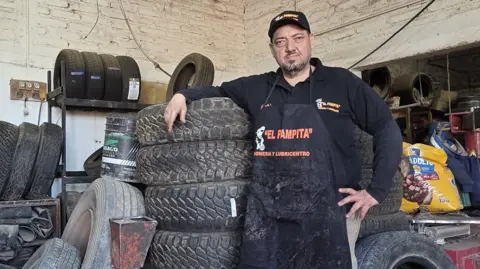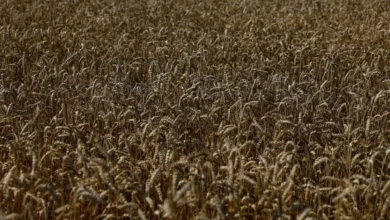Fracking has transformed an Argentine town but what about the nation?

Mechanic Fabio Javier Jiménez found himself in the right place at the right time.
When his father moved their family-owned tyre repair shop to the rural Argentine town of Añelo, it was a small, sleepy place, some 1,000km (600 miles) southwest of Buenos Aires.
There was no mains water or gas, and the electricity supply was constantly being cut off.
Then in 2014, fracking for oil and gas started in the surrounding region, and the conurbation boomed.
“We set up the tyre repair shop in the middle of the sand dunes, far from the town centre,” says Mr Jiménez. “Then the town grew and passed us by.”
Fuelled by its new-found energy wealth, Añelo’s population soared from 10,788 in 2010 to 17,893 in 2022, an increase of more than 60%.
In addition, Añelo sees some 15,000 workers enter the town each week day.
This has made the roads very busy, including lots of oil tankers going through.
Last year, 24,956 vehicles entered the town every day, of which 6,400 were lorries, official figures showed. Mr Jiménez’s workshop on the main provincial road is there to help any that need new tyres.
Añelo is located in the heart of Vaca Muerta, a 30,000 sq km (12,000 sq mi) oil and gas-rich geological formation. It was first discovered as far back as 1931, but it wasn’t until fracking became legal in Argentina in 2014 that the deposits could be commercially accessed.
Fracking is a method of mining that first became widespread in the US in the early 2000s, whereby a high-pressure mixture of water, sand and chemicals is injected into the ground. This cracks or fractures the rock, allowing the gas or oil trapped inside to be brought to the surface.

The first fracking operation in Vaca Muerta was a joint operation between Argentina’s majority state-owned oil firm Yacimientos Petrolíferos Fiscales (YPF) and US giant Chevron.
By February of this year, there were 3,358 wells in active production in Vaca Muerta, according to the Argentine Institute of Oil and Gas. Of these, 1,632 are oil, and 1,726 are gas.
This accounts “for more than half of Argentina’s oil and gas production”, says Nicolás Gadano, chief economist at the Empiria consultancy and a former YPF official.
He adds that the cost of the fracked oil is cheaper than conventional extraction elsewhere in Argentina, because the latter now comprises very old deposits where the remaining oil is hard to get to.
Nicolás Gandini, director of Econojournal, a media outlet specialising in energy, agrees. “We have not been able to find new conventional deposits that are very cost-competitive, with the exception of conventional gas deposits in the offshore southern basin,” he says. “All other onshore deposits are three to four times more expensive than Vaca Muerta.”

The oil and gas from Vaca Muerta has given Argentina energy self-sufficiency, overturning decades of shortages and the need for expensive imports. It has also allowed Argentina to export oil and gas, helping it to earn foreign currency.
“Last year, there was a significant external surplus in the energy sector of $6bn [£4.6bn],” says Mr Gadano. “This year, we are aiming for a similar figure, with much higher volume but lower prices due to the drop in international prices.”
Mr Gandini adds that the fact Argentina is now exporting more energy than it imports “is very important” for the country, “especially when two or three years ago we were in the red”. Yet he adds that it won’t be “the panacea” that cures an Argentine economy that has long battled high inflation and public spending, and defaulting on its national debt.
“I think there is an overrepresentation of the value that Vaca Muerta can bring to solving the structural problems facing the Argentine economy,” he says.
“However, if one looks at what Argentina has today to generate more dollars, it does not have many sectors other than Vaca Muerta. It has agriculture, but agriculture also has its problems: the country has not been able to expand its agricultural production base. Beyond agriculture, mining lags far behind.”










